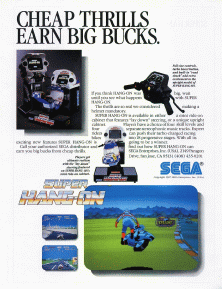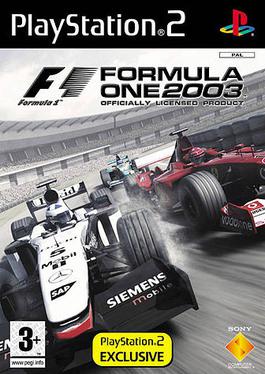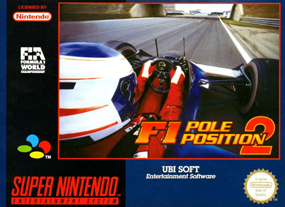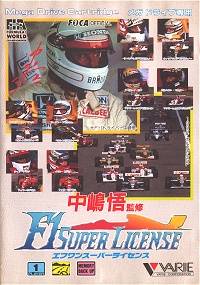
Virtua Racing or V.R. for short, is a Formula One racing video game developed by Sega AM2 and released for arcades in 1992. Virtua Racing was initially a proof-of-concept application for exercising a new 3D graphics platform under development, the "Model 1". The results were so encouraging that Virtua Racing was fully developed into a standalone arcade title.

Satoru Nakajima is a Japanese former racing driver and motorsport executive, who competed in Formula One from 1987 to 1991.

Super Hang-On is a motorcycle racing arcade video game released by Sega as the sequel to Hang-On. It uses a simulated motorcycle arcade cabinet, like the original game. An updated version was released in arcades 1991 as Limited Edition Hang-On.

Formula One 2003 is a 2003 racing video game developed by Studio Liverpool and published by Sony Computer Entertainment for the PlayStation 2. It is a sequel to the 2002 video game Formula One 2002 and was based on the 2003 Formula One World Championship.

SD F-1 Grand Prix is a Japan-exclusive video game based on the F1 Grand Prix series. This video game spin-off was developed for the Super Famicom by Video System.

F1 is a 1993 racing video game published by Domark, based on Vroom, a game developed in 1991 for the Atari ST by French company Lankhor. It was released for the Mega Drive/Genesis, Master System, Game Gear, and Amiga.

Ayrton Senna's Super Monaco GP II is an arcade-style Formula One racing video game developed and manufactured by Sega for the Sega Genesis, Master System, and the Game Gear in 1992. It is a follow-up to Super Monaco GP. The game was also endorsed by, and had technical input from, the then-Formula One champion Ayrton Senna. Gameplay includes a World Championship season featuring recreations of the tracks in the 1991 Formula One World Championship, along with a three-race "Senna GP" mode set on fictional tracks.

Super Monaco GP is a Formula One racing simulation video game released by Sega, originally as a Sega X Board arcade game in 1989, followed by ports for multiple video game consoles and home computers in the early 1990s. It is the sequel to the 1979 arcade game Monaco GP. The arcade game consists of one race, the Monaco Grand Prix, but later ports added more courses and game modes based on the 1989 Formula One World Championship.

F-1 World Grand Prix, developed by Paradigm Entertainment, is a Formula One racing game/sim first released in 1998 for the Nintendo 64 game console and to later platforms including the Sega Dreamcast, Microsoft Windows, Sony PlayStation, and Game Boy Color. The Nintendo 64 version is based on the 1997 Formula One season, featuring each of the 17 circuits from the season and all 22 drivers, with the exceptions of Jacques Villeneuve and the MasterCard Lola team.

F1 Pole Position 64, released in Japan as Human Grand Prix: The New Generation, is a racing video game for the Nintendo 64 developed by Human Entertainment and published by Human Entertainment in Japan, and published by Ubi Soft for North American and Europe. It is the fifth and final game in the Human Grand Prix / F1 Pole Position series, featuring Formula One branding.

Al Unser Jr.'s Turbo Racing is a racing video game for the Nintendo Entertainment System console released in 1990. It is an adaptation of the 1989 Japanese-market Famicom game World Grand Prix - Pole to Finish, with the most notable changes being the addition of Unser as an in-game coach, the number of laps, sound and interface design. Therefore, the game remains based on the Formula 1 World Championship, despite Unser having never competed in it. This game features a season mode and two time trial modes. In season mode the player uses either Al Unser Jr. or a make-their-own-driver.
Nakajima Satoru F-1 Hero is a video game developed by Human Entertainment released for the Nintendo Entertainment System in 1990. It starred American Indy car driver Michael Andretti, and featured the full sixteen-race schedule of the FIA Formula One World Championship circuit.

Formula One: Built to Win is a 1990 racing video game for the Nintendo Entertainment System developed by Winkysoft and published by SETA Corporation.

Fastest 1 (ファステスト・ワン) is a Sega Mega Drive racing game video game released in 1991 exclusively in Japan. During the release of this video game, other Formula One video games like Super Monaco GP had caused a general increase of demand for Formula One video games. While most of those games were poor simulations of the races, Fastest One proved to be the most realistic of the era.
Ever since Pole Position in 1982, Formula One (F1) has always played a part of the racing genre in video games. Early Formula One games were typically arcade racing games, before Formula One Grand Prix (1991) popularized Formula One racing simulations on home computers.

Nakajima Satoru Kanshuu F1 Grand Prix is a 1991 Sega Mega Drive Formula One video game based on the career of Satoru Nakajima, who was the first full-time Japanese racer in the history of Formula One. In fact, this was the first game that Nakajima endorsed for a Japanese video gaming system. The entire 1991 Formula One season can be re-enacted with any of the notable contenders from the prestigious Formula One racing organization.

F1 Pole Position is a 1992 racing video game for the SNES, developed by Human Entertainment and published by them in Japan, while the other versions were handled by Ubi Soft. It is the first game in the Human Grand Prix/F1 Pole Position series, which features Formula One licensing.

F1 Pole Position 2, known in Japan as Human Grand Prix II, is the sequel to Human Grand Prix and the predecessor to Human Grand Prix III: F1 Triple Battle.

Nakajima Satoru Kanshū F1 Super License is a 1992 racing video game for the Sega Mega Drive that allows for either single season or exhibition modes of play. The object of the game is to acquire the championship for the 1992 Formula One season. There is an official FOCA license and uses a top-down view.

Satoru Nakajima F-1 Hero GB World Championship '91 is a 1991 Japan-exclusive Game Boy Formula One video game published by Varie, endorsed by Satoru Nakajima, who was the first full-time Japanese racer in the history of Formula One. Apart from Nakajima, the actual names of the drivers are not used due to licensing arrangements.


















